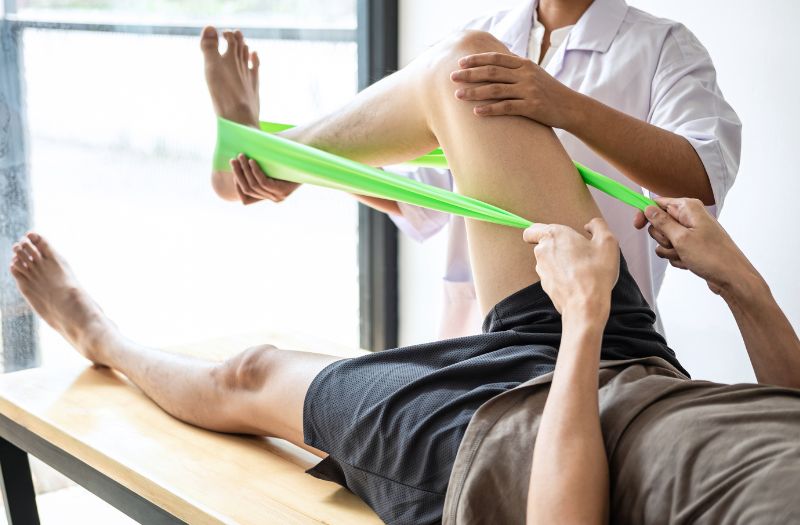When a doctor speaks of degenerative disc disease, it means that the intervertebral disc (there is one between each vertebra and the next), is losing its shape. The natural process of aging is one of the factors that can lead to this pathology. In the following article we discuss degenerative disc disease that appears at age 40.
Regardless of whether the disc disease is the result of aging or injury, it can interfere with some of your daily activities; however, surgical interventions are only needed in some very specific cases. It is worth mentioning that disc disease is rarely the result of an accident or serious injury; the most common cause is simply wear and tear on the disc, which progresses over time.
Primary causes of disc degeneration
Degenerative disc disease usually affects people who are over 30 or 40 years old. As a person ages, the intervertebral discs lose flexibility and, with it, their ability to act as shock absorbers. Below, we list the main causes of disc degeneration:
-
Dehydration, fissures, or ruptures of the disc: this can happen when a person overexerts themself in exercise, or some movement, or if their work requires significant physical effort, but these factors also occur as a part of normal aging of the disc.
-
Wear on the disc can also occur when people spend most of the day sitting, or when their job requires them to constantly tilt their body forward, as in the case of bus or truck drivers, or anyone who spends many hours a day sitting in front of a computer.
Three types of pain are associated with degenerative disc disease:
- Discogenic: this is back or leg pain without evidence of nerve root compression
- Nociceptive: muscle pain in the fascia due to contraction, spasms and osteoarthritis at the level of the facet joints
- Neurogenic: nerve root pain from compression, such as caused by a hernia
The biological origin of this pain may be related to inflammation. A degenerated disc secretes certain inflammatory proteins (cytokines) into the intervertebral space and these can produce nociceptive triggers in nearby nerves. In addition, although not always, low back pain can also produce micro-instability; this is the wear of the fibrous rings, which contain the disc, causing loss of alignment and stability along that vertebral segment.
For example, the L5-S1 is the segment of the lumbosacral spine. It fulfills a variety of functions including supporting the upper body and allowing movement in multiple directions. When a person suffers from degenerative disc disease at L5-S1, it can compromise that support for the upper body and cause some movements to become difficult.
Most common spine pathologies by age group
Symptoms of degenerative disc disease
Sometimes disc degeneration does not cause any symptoms and is only discovered during a routine examination through magnetic resonance imaging (MRI) or a CT scan. For this reason, it is important to see a specialist regularly if you suffer from back problems. The professionals at Instituto Clavel are highly skilled in diagnosing this type of pathology.
Lumbar disc disease: symptoms
Symptoms can vary from patient to patient, but common symptoms are:
- Back pain, specifically in the lower back, which does not improve after approximately 6 weeks. It can get worse when the person is sitting, as this position puts a heavier load on the discs.
- Numbness and tingling in the legs, as well as difficulty walking.
Cervical disc disease: symptoms
The symptoms of degenerative disc disease in the cervical spine are of the lumbar spine, with the difference that they occur in the neck:
- Neck pain with stiffness and rigidity.
- Numbness, tingling, or feeling of weakness in the neck, arms, or shoulders.
- Altered sensation in the fingers or fingertips, depending on the spine segment where the damaged disc is located.

Treatment for degenerative disc disease at age 40
The treatment is not especially different from that applied to people of other ages with the same condition. When the patient suffers pain and difficulty making certain movements, but there is no disc herniation, physical therapy is prescribed to relieve discomfort.
Our team of professionals at Instituto Clavel Rehabilitation uses manual techniques combined with active therapy to treat the neuromusculoskeletal system with the aim of improving mobility, increasing quality of life and preventing any relapse.
Our physical therapists will also explain how to do some exercises at home, and the correct posture to use when walking, sitting, or lying down, so that you can work to improve your symptoms as you go about your daily life.
In the case of a disc herniation, however, the doctor will consider other treatment options. Ideally, the first step is to try using conservative treatments, but if these fail, the specialist may recommend surgery. At Instituto Clavel we always opt for the least invasive option, such as anterior approach disc replacement (ADR) surgery.
Categories: Spine treatments, Spine pathologies, Back pain
